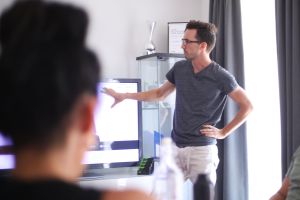What We Learned at Web Directions 2016
Updated 15 January 2020 (Published 22 November 2016) by Miles in Website design & UX
This year, a few members of the Bam Creative team got the opportunity to attend Direction 2016, a conference that focusses on the future of the web.

This year it was held in the Seymour Centre in Sydney with 17 transformational speakers who spoke about a number of interesting and exciting topics surrounding the web. Here are a few of the standout talks that really got us inspired.
Magical UX and the internet of things
The keynote speaker was author of “Designing for touch” and founder of Big Medium, Josh Clark. Clark spoke about the similarities between magic and great design, and challenged the idea that engagement is the best measure of successful design. He even demonstrated some real magic!
The talk encouraged creators to “design for the things thingness”, and embrace developing technology that extends our will rather than replaces it. The tech industry continues to rapidly develop, but many creators get caught up designing the novel. We’ve focused on what we could do, without considering whether they should. There was an emphasis on creating technology that enables what we do rather than distracts us from it.
Clark used the example of Propeller, an attachment for Asthma inhalers that tracks data about the inhalers use, and gives advice on how to best manage your Asthma. The attachment connects with the user’s mobile device via an application, and gives valuable insight into both personal and public health, like common locations that trigger Asthma attacks.
This device seamlessly integrates itself with the inhaler without distracting the user from its primary use, and enhances it by providing useful and actionable data. This makes it a great example of designing for the things thingness.
Tragic design: The real cost of bad design and how to fix it
After morning tea, we were privileged to listen to the talk by the author of “Tragic Design”, and Director of Product and design at Therapydia, Jonathon Shariat. Shariat’s talk encompassed believing in the potential of technology and considering the implications of our products’ design. As designers and creators, we often have the inclination to look only at the best case scenario. Shariat encouraged listeners to consider how our designs could create emotional, or physical harm, or could foster exclusion or promote injustice.
Shariat gave an example of how the ergonomics of our designs could cause physical harm. With the everyday use of mobile devices, positioning of elements is extremely important. Forcing users to tap elements in hard to reach areas of their mobile device can be very uncomfortable and even damaging. The talk really illuminated the inherit bias that we all have. It encouraged us to acknowledge our own biases and design accordingly.
Scaling walls: The barriers to female representation and how Atlassian is eliminating them
A common theme over the 2-day conference was a focus on diversity and inclusion in the tech space, which was further emphasised by the result of the U.S. election. Global head of Diversity and inclusion at Atlassian, Aubrey Blanche gave a fantastic talk on some of the measures that they had taken to make the hiring process more inclusive.
Upon finding that their graduate program had literally zero female applicants, the team at Atlassian endeavoured to find out why. As it turns out, the application listing, whilst trying to find the best candidates possible, was unintentionally discouraging women from applying.
They found that women were experiencing what’s called a “confidence gap”. This means that when compared to their male peers, equally qualified women are more likely to be less self-assured or confident in their abilities and skills. It’s been discovered that when applying for jobs, men will apply when they meet only 60% of the qualifications, whereas many women won’t apply unless they meet 100% of the listed qualifications.
To combat this, Atlassian decided to change the wording of their job and program listings to be more inclusive of what women look for in a job or company. Instead of using common terms that appeal to men such as “rockstar”, “ninja” or “expert”, they focussed on culture, highlighting features such as flexible work hours and collaboration. Rather than having a long list of technical requirements, they opted for a short list of transferrable skills. They focused on experience, rather than the means of obtaining that experience and conveyed that all skills related to the role were coachable and learnable.
By making these changes, they found that the percentage female applicants had increased dramatically and was almost equal to the amount of male applicants. They applied these types of changes all throughout the hiring process to ensure that they weren’t dissuading potential candidates so that they can have a diverse range of talent. It is proven that diverse teams perform better, and fostering inclusive processes and environments can only improve workforces.
To be shown the proof and benefits of engaging in inclusive language and tone, was very illuminating. Blanche encouraged us to look at our own processes and challenged us to be better allies to people in minority groups. She left us with the statement “Diversity isn’t the end goal; it is the mechanism to achieve greatness” and we couldn’t agree more!
WebVR: Building and browsing cyberspace
Another common theme of the conference was the excitement around virtual and mixed realities and how we are able to bring that to the web. Multiple talks featured it and there were demos of VR devices available around the centre. Virtual reality is becoming more and more imminent with multiple large tech companies investing in developing their own VR devices. Google Cardboard made VR accessible with its release in 2015, and demand and interest has grown ever since.
Mark Pesce gave a fantastic overview of some of the technologies that are available now to bring VR to the forefront of the web. Many new developments including VR standard API for browsers, and frameworks such as A-Frame and Three.js are making VR more and more accessible to broader audiences.
He first gave us a crash course overview the elements of what makes up the scenes that we can experience in virtual reality. As it turns out, it’s relatively simple!
A scene is composed of three elements:
- Objects: the things we see, which are made up of geometry and material
- Lights: they illuminate the objects
- A camera: looks at the objects illuminated by lights
The main framework demonstrated was A-Frame, a web framework for building virtual reality experiences. The amazing thing about these technologies is that they are already widely supported and relatively easy to learn. A-Frame in particular follows a similar syntax and structure to HTML and leverages off the devices graphics card to create complex and extensive experiences.
With the development of this technology, there was much talk of how we can utilise virtual, mixed and augmented reality to help promote connection rather than foster isolation. VR is a wonderful tool for eliciting empathy, and helping people literally walk in the shoes of others. We have such an amazing power to share experiences using this technology, and we’ll need to learn how to best engage with this type of sensual computing.
Virtual, mixed, and augmented reality have such great and exciting potential, and it’s never been a more exciting time to be engaged in the web industry! The future is here!
Summary
All-in-all, Direction 2016 was a huge success and captured the Bam Creative team’s interest with the future potential of the web. We’re very excited to bring our learnings into our work, and build some cool stuff with new technologies! Major kudos to John Allsopp, the conference co-founder, organiser, and long-time friend to Bam Creative. Thank you for being a driving force for the development of the web and tech industry in Australia. We can’t wait for Direction 2017!


